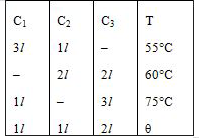Three containers C1,C2 and C3 have water at different temperatures. The table below shows the final temperature T when different amounts of water (given in litres) are taken from each containers and mixed (assume no loss of heat during the process)

The value of (in °C to the nearest integer) is …….
The correct Answer is:50
According to table and applying law of calorimetry
2T1+2T2=(2+2)45∘ .....(1)
3T2+1T3=(3+1)65∘ .....(2)
T1+2T3=(1+3)67.5∘ .....(3)
Solving T1=30∘,T2=60∘,T3=80∘
Hence, 2T2+T2+T3=(2+1+1)θ, 200=4θ,θ=50∘C
Topper's Solved these Questions
Similar Questions
Three containers C1,C2andC3 have water at different temperatures. The table below shows the final temperature T when different amounts of water (given in litres) are taken from each containers and mixed (assume no loss of heat during the process)

The value of θ (in ^(∘)C to the nearest integer) is …….
View SolutionThree containers C1,C2andC3 have water at different temperatures. The table below shows the final temperature T when different amounts of water (given in litres) are taken from each containers and mixed (assume no loss of heat during the process)

The value of θ (in ∘C to the nearest integer) is.......
View Solution
Knowledge Check
The isothermal diagram of a gas at three different temperatures T1,T2andT3, is show in the given figure .Then
 Aa.T1<T2<TBb. T1<T2>T3Cc.T1>T2>T3Dd.T1>T2<T3
Aa.T1<T2<TBb. T1<T2>T3Cc.T1>T2>T3Dd.T1>T2<T3One gram of water at 100∘C is converted to steam at the same temperature. The amount of heat required is nearest to the value of
AzeroB336 JC540 JD2257 J
Three containers C1,C2andC3 have water at different temperatures. The table below shows the final temperature T when different amounts water (given in liters) are taken from each container and mixed (assume no loss of heat during the process)

The value of θ (in .∘C to the nearest integer) is ------------
View SolutionFigure shown two adiabatic vessels, each containing a mass m of water at different temperature. The ends of a metal rod of length L, area of cross section A and thermal conductivity K, are inserted in the water as shown in the figure. Find the time taken for the difference between the temperature in the vessels to become half of the original value. The specific heat capacity of water is s. Neglect the heat capacity of the rod and the container and any loss of heat to the atmosphere.

View SolutionThe temperature inside a refrigerator is t2 C and the room temperature is t1 C. The amount of heat delivered to the room for each joule of electrical energy consumed ideally will be
View Solution1 mol of an ideal gas undergoes different thermodynamical process in P−V digram given below :

If temperature at point C is TK then :
View SolutionTwo rigid boxes containing different ideal gases are placed on a table. Box A contains one mole of nitrogen at temperature T0, while Box contains one mole of helium at temperature (73)T0. The boxes are then put into thermal contact with each other, and heat flows between them until the gasses reach a common final temperature (ignore the heat capacity of boxes). Then, the final temperature of the gasses, Tf in terms of T0 is
View SolutionTwo rigid boxes containing different ideal gases are placed on a table. Box A contains one mole of nitrogen at temperature T0, while Box contains one mole of helium at temperature (73)T0. The boxes are then put into thermal contact with each other, and heat flows between them until the gasses reach a common final temperature (ignore the heat capacity of boxes). Then, the final temperature of the gasses, Tf in terms of T0 is
View Solution

